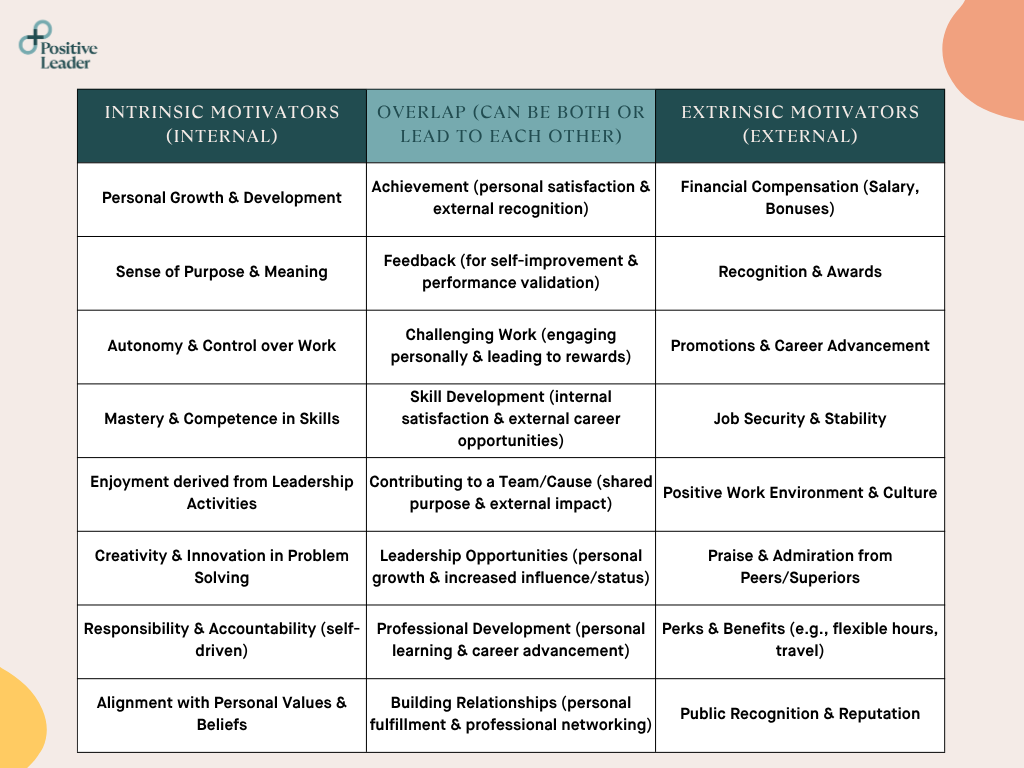What Motivates a Leader? Understanding the Key Drivers of Effective Leadership

Whether you’re leading a team yourself or looking to hire, mentor, and build leaders in your organization, motivation is one of the most powerful tools in your leadership arsenal.
Understanding the ins, outs, and whys of personal motivation acts like jet fuel when it comes to shaping a winning team and inspiring employees to their true potential. Of course, what motivates someone is highly personal and your approach to motivating your team should be just as individualized. It’s one of those situations where the best place to start is with yourself: Take the time to learn and define what motivates you as a leader and you’ll be poised and ready to inspire your team. Here’s how.
What Does a Motivated Leader Look Like?
We have some clues that let us know whether or not your organization is inspiring motivated leaders. Motivated leaders are champions of open and clear communication. Everyone on the team feels empowered to pick up the phone, ask questions, and offer feedback. Motivated leaders also exhibit high emotional intelligence by leading others using both intrinsic and extrinsic motivation, so employees understand their KPIs but also understand why the KPIs are what they are. It’s an organization with a high growth mindset where employees are accountable, loyal, and operate with 360-degree perspective.
And what does this motivated leader—who also inspires motivated employees—look like? We know a leader is highly motivated when they display the following factors and characteristics:
- Vision with Clarity. It’s important to call out exactly the type of vision a motivated leader works with. It’s not just a deep set of values that only they have access to as the all-powerful manager. It’s using that vision to clearly paint a picture for others. What does success look like and why? How are we going to accomplish our KPIs and why did we choose those benchmarks? Clear vision builds trust, engagement, and motivation throughout the team.
- Enthusiasm and Buzz. A motivated leader knows how to show enthusiasm and generate buzz for everything from sales numbers to change management. Motivated leaders utilize high emotional intelligence to match employees to the goals and ideas that inspire them the most.
- Purpose and Drive. It’s not enough to explain your desired outcome and hope that employees engage on their own accord. Some might, but specific goals don’t motivate everyone. Instead, the purpose (goals and KPIs) must be combined with the drive (transparency behind why you’ve chosen those goals and how you want to achieve them). By defining not only what success looks like but the best path to achieve it, you empower and inspire employees to reach for those benchmarks.
- Resiliency and Self-Regulation. Not everyone will agree with your enthusiasm, your plans for meeting goals, or even your desired outcomes. A motivated leader, however, doesn’t allow that criticism to knock them off-kilter. Instead, they receive criticism and listen carefully to concerns. They put their ego aside and if necessary, pivot quickly. If everyone is motivated to be part of the same team, a leader knows that all feedback is worthy of consideration.
In contrast, we know that an organization is struggling with motivation when the only inspiration employees get is “do it this way or get fired.” Simply staying employed is rarely enough for employees to stay motivated and loyal to the organization. It’s that lack of care and culture that leads them to disengage or look for another job.
How Intrinsic and Extrinsic Motivation Shape Leadership Success
In a perfect world, everyone would only have the purest intentions and work hard because they take personal pride in a job well done. But intrinsic motivation is sometimes falsely inflated in a workplace setting. Sure, we love when employees drive success because they’re hardwired for personal growth, but they can also be tricky from a leadership standpoint. Understanding intrinsic and extrinsic motivation as a leader means delving deeper into its implications for day-to-day operations and how you manage employees’ natural inclinations.
Consider the following scenario: You’re a leader who wants to implement AI to automate certain tasks. You’ve run the numbers and know it’ll be far more efficient and your next task is to introduce the new protocol to employees. Your intrinsically-motivated employees are naturally curious and always interested in something new, right? Probably. But that same interest extends to many different things. They might buy into the new AI protocol only to get caught up in the next new technology—without ever really understanding or learning the protocol you’ve introduced.
Contrast that to extrinsically motivated individuals. They likely need a clear understanding of how this new technology will benefit them directly. Will it make their job easier or faster? Will mastering it gain them admiration and praise? Then they’ll buckle down and buy in without getting sidetracked by anything new. See, we often downplay extrinsic motivation, but when properly applied, it has its benefits too.
The objective isn’t merely to hire employees who only respond to intrinsic or extrinsic motivation; it’s to understand what motivates each individual and how to leverage that understanding to keep employees (and yourself) engaged. One type of employee isn’t superior to the other, but it takes a leader who understands deep motivation to adapt their approach and apply it properly to each team member.

Intrinsic Motivators
Intrinsic motivators for leaders come from within, driven by personal satisfaction and a deep-seated desire to excel. These are the internal rewards that fuel a leader’s passion and commitment.
- Sense of Purpose: A strong belief in the mission and vision of the organization or team.
- Personal Growth: A continuous desire to learn, develop new skills, and expand one’s capabilities as a leader.
- Autonomy and Control: The ability to make decisions and direct their work and team, fostering a sense of ownership.
- Mastery and Competence: Striving for excellence and continually refining leadership skills and knowledge.
- Enjoyment of the Work: Genuine pleasure and satisfaction derived from the challenges and responsibilities of leadership.
- Alignment with Values: Leading in a way that is consistent with one’s personal ethics and beliefs.
Extrinsic Motivators
Extrinsic motivators for leaders are external rewards or incentives that drive behavior. While internal drives are powerful, external factors also play a significant role in a leader’s motivation and performance.
- Financial Compensation: Salary, bonuses, and other monetary rewards tied to performance and responsibility.
- Recognition and Awards: Public acknowledgment, accolades, or formal awards for achievements and contributions.
- Promotions and Career Advancement: Opportunities to climb the organizational ladder, take on higher-level roles, and increase influence.
- Job Security: The assurance of continued employment and stability within the organization.
- Positive Work Environment: A supportive, collaborative, and appreciative culture that makes leadership enjoyable.
- Public Reputation: Building a positive professional image and gaining respect from peers and the industry.
- Perks and Benefits: Non-monetary advantages such as flexible work arrangements, professional development budgets, or exclusive privileges.
| Intrinsic Motivators (Internal) | Extrinsic Motivators (External) | Overlap (Can be both or lead to each other) |
| Personal Growth & Development | Financial Compensation (Salary, Bonuses) | Achievement (personal satisfaction & external recognition) |
| Sense of Purpose & Meaning | Recognition & Awards | Feedback (for self-improvement & performance validation) |
| Autonomy & Control over Work | Promotions & Career Advancement | Challenging Work (engaging personally & leading to rewards) |
| Mastery & Competence in Skills | Job Security & Stability | Skill Development (internal satisfaction & external career opportunities) |
| Enjoyment derived from Leadership Activities | Positive Work Environment & Culture | Contributing to a Team/Cause (shared purpose & external impact) |
| Creativity & Innovation in Problem Solving | Praise & Admiration from Peers/Superiors | Leadership Opportunities (personal growth & increased influence/status) |
| Responsibility & Accountability (self-driven) | Perks & Benefits (e.g., flexible hours, travel) | Professional Development (personal learning & career advancement) |
| Alignment with Personal Values & Beliefs | Public Recognition & Reputation | Building Relationships (personal fulfillment & professional networking) |
Assessing Motivators
Motivating your team starts long before you need to introduce a new goal or push for specific KPIs. It starts during the interview process, where you learn more about the individual and what approach is most likely to inspire them. Here’s the rub, though: Because intrinsically motivated individuals are often prized above others, a simple interview might not give you the insight you need.
Maybe someone tells you they love to learn. It sounds inherently intrinsic because learning is a personal pursuit. But why do they love to learn? Is it because they have a growth mindset or do they love to impress others with their knowledge base? That’s an extrinsically motivated individual.
It’s why we always recommend an assessment tool like the PAT to delve deeper into what makes a candidate tick and how they’ll fit into your team. It’s not enough to know what inspires employees, but why they gravitate toward that type of motivation. Armed with that level of insight, you’ll be better able to build, maintain, and drive a truly motivated team.
